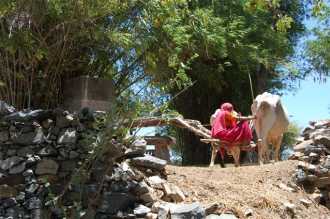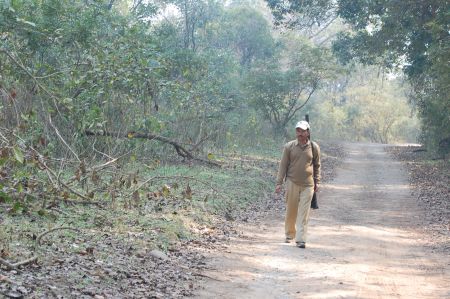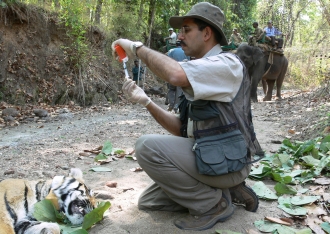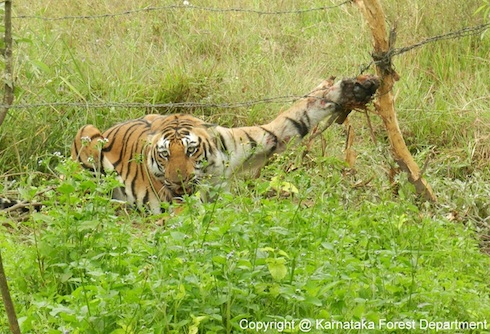Kalya Bawaria of Bigotha village near Sariska Tiger Reserve, a notorious trader in the wildlife products was sentenced to a four-year jail term and fined Rs. 30,000 on 6 June 2007. He was sentenced for trading parts of a tigress that had been killed by fellow villagers Rampratap Meena and Loharya Meena during the height of the tiger crisis in 2005. They killed the tigress to avenge the killing of their buffalo. The incident was symptomatic of the anthropogenic conflict plaguing tiger conservation.
It was on 4 March 2005 that Rampratap Meena confessed to the field director of the Sariska Tiger Reserve that he alongwith Ramsukh alias Loharya Meena had killed a tigress by ensnaring it. When Rampratap discovered that one of his cattle had not returned home, he combed the jungle nearby alongwith his accomplice Loharya Meena. They found the carcass of the buffalo near a waterhole with fresh tiger pug marks around. Both the Meenas headed back to the village, bought wrought iron parts for Rs.200, and assembled a foot trap.

![]() Sambhar is the favourite prey of tigers, but there are no tigers left in Sariska Tiger Reserve today.
Without carnivores, it could possibly lead to an artificial super abundance of ungulates. The ungulates
are particularly vulnerable to viruses because they share the same habitat with cattle that the villagers
bring to the forests to graze. Pic: Malini Shankar.
Sambhar is the favourite prey of tigers, but there are no tigers left in Sariska Tiger Reserve today.
Without carnivores, it could possibly lead to an artificial super abundance of ungulates. The ungulates
are particularly vulnerable to viruses because they share the same habitat with cattle that the villagers
bring to the forests to graze. Pic: Malini Shankar.
They went back to the kill armed with an axe, a torch and the foot trap. They laid the trap at the opening of the hide and waited for the tiger. They lopped tree branches and hid the carcass from three sides, and hid themselves in the tree. The beast returned around 2.00 am that night. Trapped immediately, the injured tigress wailed in agony for more than an hour. When it slipped into comatose, Rampratap fired three times at the tiger. Alighting from the tree, they skinned the tiger, hid the carcass and the skin in the undergrowth and returned to the village.
The next day they made a deal with wildlife trader Kalya Bawaria. Bawaria bought his 'Mal' from Rampratap for Rs.25000. In the international market the skin could fetch as much as Rs.6,48,800 (US $16,000) according to the report Skinning the Cat, 2005, brought out by Wildlife Protection Society of India and Environmental Investigation Agency.
What prompted Rampratap's confession? Speculation abounds if it was voluntary or did it follow a departmental enquiry? Coincidentally, about a week before Rampratap's confession, the complaint letter from Mohar Singh Bawaria of the Jaitpur Sillibaori village, on the fringe of Sariska reached the desk of the office of the Principal Chief Conservator of Forests R N Mehrotra, after an inexplicable delay of six months. On 27 August 2004, Mohar Singh Bawaria had complained in the letter to the RFO, Om Prakash Parikh, of the Tehla Range of the Sariska Tiger Reserve that nine members of a particular gang were poaching tigers. The RFO acknowledged receipt of the complaint letter on 2 September 2004 but did not forward it to the PCCF till 27 February 2005.
This period coincided with the systematic annihilation of tigers in Sariska. Twenty-two tigers were killed in a single Project Tiger Reserve, and the Sariska Shock was an eye opener.
Twenty-two may seem a small number, but tiger numbers in India had always been exaggerated in officialdom. When a former field director of Sariska Tiger Reserve, Deepak Bhatnagar, who estimated that there were only around 16 to 18 tigers, asked for a recount, he was transferred to Bikaner, on the Pakistan border! Even today, three years after the shock, a television film snippet claims Project Tiger as one of the defining moments of India's 60th year of independence. The film explicitly mentions that in 1973 when Project Tiger was launched there were 1827 tigers left in the country by the 1990s there were 3600 tigers. The film conspicuously avoids mentioning the Sariska Shock. The official website of Project Tiger now says that there are only 1576 tigers in India (http://www.projecttiger.nic.in/populationinstate.asp)
Before they were hunted by poachers, 22 tigers across 881 square kilometres had congested the prey-base for more than one carnivore.
The tiger's favourite prey, the Sambhar, is multiplying almost unchecked, leading to an unnatural super abundance in its numbers.

•
Tiger conservation in Sariska
•
Forest fights, Indian style
"Villagers are sandwiched between the park administration and the tiger and are bitter about their desperately wretched existence and continued harassment people versus the tiger is the inevitable corollary of the conservation debate... the poorest 150 districts of India that are primary tribal areas are also prime tiger habitats Enter the tiger and single males that no fiat can tie down, trying to wander from forest to shrinking forest but unable to do so" wrote Sunita Narain, the chairperson of the Task Force, in her report Joining the Dots. The report was released in August 2005.
While The Task Force saw in the crisis an 'opportunity' to document the hardships of forest dwellers, the biodiversity conservationists saw the report as 'an eye wash', for, the report sympathised more with those who killed tigers. "The TTF report virtually pitched tiger conservation against the poor people" criticises Belinda Wright, of the Wildlife Protection Society of India.
Nevertheless, Narain has indeed made a very stark if damning point in documenting the hardships of these villagers. The Gujjars, Meenas and Moghiyas, are tribal people, landless, who trek down cliffs over 500 metres to fetch water. They have nothing more than harsh sunlight and voting cards, they depend on forest resources for hand to mouth existence. They count on carnivores to cull their virus infected cattle. They lack ownership documents; without which, they cannot negotiate for any better deal outside their forest homes. Their perception is that the Forest Department made them ecological refugees by defining its boundaries; the forest department's initiative to relocate villagers is frustrated because of the 'unrealistic' set of demands placed by the tribes. "Without ownership documents their demands for higher standard of living complicates the relocation process," says DCF Murarilal Sharma at Sariska.
The TTF report advocated that till such time that the lot of the impoverished villagers improves, expecting them to stop objectifying the fascinating tiger would be futile. Tiger Conservation will remain a fallacy amongst the urban noveau riche, warned the report.
Since the crisis though, protection did improve. In Ranthambhore, the forest department has entrusted responsibility to the guards. Forest guards must report sighting of wildlife in their beats and sections daily. They now maintain a registry of wildlife sighting and tracking. All guards, watchers and foresters, must record in the registry, sightings of wild animals in their sections and beats, besides make plaster casts of pug marks of all carnivores they sight every day. Night patrolling has resumed in both the tiger reserves now, pushing the poachers to the South Indian Tiger Reserves.
But three years since the Sariska events, PCCF R N Mehrotra says that all is still not well at Sariska itself. After the Sariska shock the Prime Minister visited once, he notes, and thereafter there has been no political will at all. "In fact ever since the Gandhi family has not been at the helm, there has been no political will for tiger conservation," says Mehrotra. Mehrotra refers to the Gandhi family because the Gandhi family was known for its environmental consciousness. But today, Project Tiger has no funds to spare for wireless sets, weapons and torches, rue Mehrotra. If they had a better compensation package, facilities, infrastructure, living conditions and motivation, there would have been far better results, according to him. "There has been no fresh recruitment to the vacant posts, those appointed have not reported to duty," says Mehrotra.
Also, accountability was and still is a casualty. The Sariska RFO, Parikh, who did not forward the complaint letter on poaching to higher ups was suspended only after the incident made international headlines. While Bawaria was sentenced to jail, Rampratap Meena and Loharya Meena were released on bail. If the Meenas' confession was not good enough a material fact in a court of law, it was the responsibility of the forest officials to conduct further investigations, recover material evidence, and impose fines atleast - if not more than the value of the contraband; and ensure conviction of the self confessed criminals. But Bawaria's crime was greater as he traded in wildlife parts, according to the logic of the Wildlife Protection Act and the forest department. The reasoning is, without trade conduits like Kalya Bawaria and Sansar Chand, their field persons including the poachers would be jobless.
The National Wildlife Crime Bureau is yet to become functional, three years after the scandal, pending an amendment to the Wildlife Protection Act. Cases of wildlife crime need to be tried and concluded expeditiously. Foresters must be trained in criminal investigation. A separate wildlife court has to be set up to try the wildlife cases. The government must pull its act together and remain alert to wildlife crime. The foot soldiers' grievances ought to be better addressed to fructify real conservation. Simultaneously the government must relocate compassionately the people living in the reserves by catering to their reasonable needs. Till such time that these three priorities converge seamlessly the tiger will remain threatened severely.









































